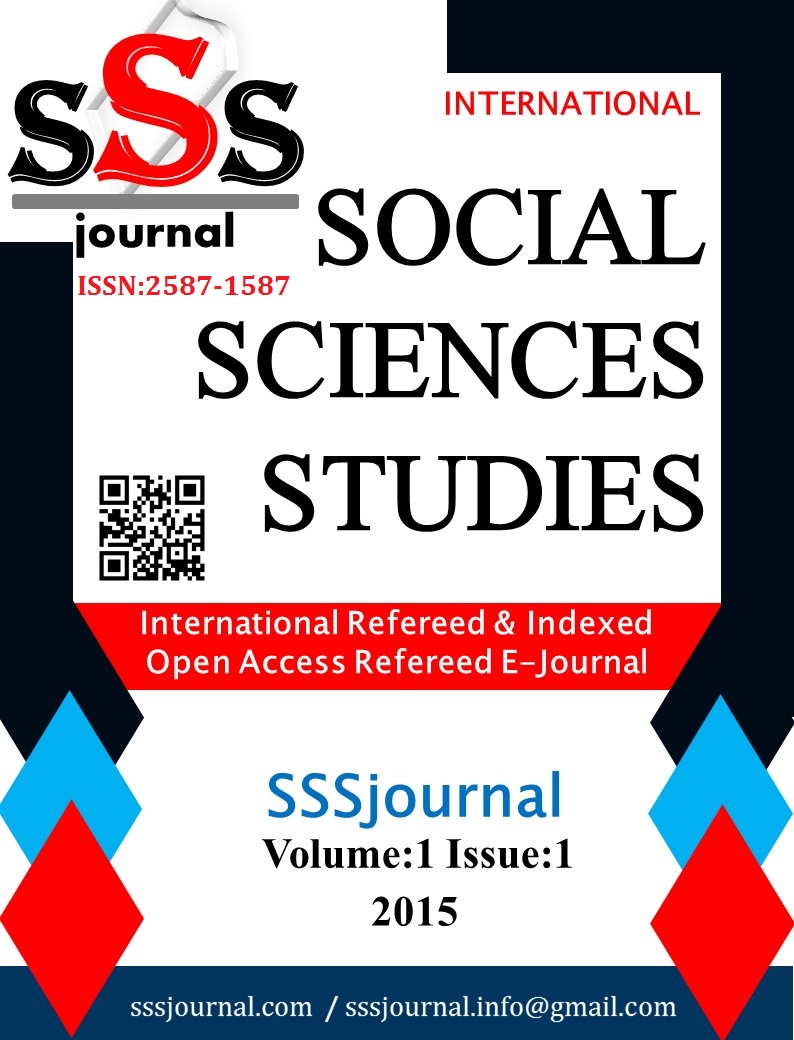Author :
Abstract
Bu çalışmanın genel amacı; bilgi yönetiminin örgütsel sapma davranışları arasında ilişki olup olmadığını belirlemeye yöneliktir. Çalışma, örgütsel bilgi yönetimi algısı ve alt boyutları ile örgütsel sapma davranışları ve boyutları arasındaki ilişki olup olmadığını belirlemeye yönelik olduğundan ilişkisel model olarak tasarlanmıştır. Araştırmanın evrenini Gaziantep ilinde imalat sektöründe orta ölçekli işletme statüsünde olan 357 adet işletmede çalışan toplam 19.864 personel oluşturmaktadır. Araştırma grubunu ise ana evreni temsilen 382 katılımcı oluşturmaktadır. Araştırmada veri elde etmek için Churchill (1979) tarafından geliştirilmiş ve Lee, Lee ve Kong (2005) tarafından kullanılmış olan “bilgi yönetimi ölçeği” ile Robinson ve Bennett (1995) tarafından geliştirilen “Örgütsel Sapma Ölçeği” kullanılmıştır. Verilerin istatistiki çözümlerinde SPSS 21.0 programı kullanılmıştır. Elde edilen bulgulara göre bilgi yönetimi ve örgütsel sapma davranışları arasında düşük düzeyde istatistiki yönden anlamlı negatif bir ilişki olduğu görülmektedir. Bu sonuçla birlikte bilgi yönetimine yönelik çalışmaların, örgütsel sapma davranışlarını azaltabileceği sonucuna ulaşılmıştır.
Keywords
Abstract
The overall goal of this study is to determine if there is any relation in the organizational deviation behaviors of information management. The study was designed as a relational model because it was intended to determine whether there is a relationship between organizational knowledge management perceptions and subdimensions and organizational deviance behaviors and dimensions. The universe of the study is composed of 19.864 personnel who work in 357 enterprises operating in the manufacturing sector with a medium-sized enterprise status in Gaziantep. The research group is composed of 382 participants representing the main universe. The "information management scale" developed by Churchill (1979) and used by Lee, Lee and Kong (2005) and the "Organizational Deviation Scale" developed by Robinson and Bennett (1995) were used in the research to obtain data. SPSS 21.0 program was used for statistical analysis of data. According to the findings, it is seen that there is a significant negative correlation between the knowledge management and organizational deviation behaviors statistically at low level. With this result, it has been concluded that the studies on knowledge management can reduce the organizational deviation behaviors.
Keywords
- Alavi, M. & Leidner, D.E. (2001). Knowledge Management and Knowledge Management Systems:
- Alavi, M. & Leidner, D.E. (2001). Knowledge Management and Knowledge Management Systems: Conceptual Foundations and Research Issues, MIS Quarterly, 25(1):107-136.
- Appelbaum, S.H. Iaconi,G.D. & Matousek, A. (2007). Positive and Negative Deviant Workplace Behaviors: Causes, Impacts and Solutions. Corporate Governance, 7 (5), 586-598.
- Arbak, Y., Şanlı, Y.A. & Çakar, U. (2004). İşyerinde Sapkın Davranış: Akademik Personel Üzerinde Yerel Bir Tanım ve Tipoloji Çalışması. Yönetim Araştırmaları Dergisi. 4(1): 5-24.
- Avcı, N. (2008). Konaklama İşletmelerinde Örgütsel Öğrenme, İş Tutumları ve Örgütsel SapmaArasındaki İlişkinin Analizi. İzmir: Dokuz Eylül Üniversitesi Sosyal Bilimler Enstitüsü. Yayımlanmış Doktora Tezi.
- Baron, R.A. & Neuman, J.H. (1996). “Workplace Violence and Workplace Aggression: Evidence on Their Relative Frequency and Potential Causes”, Aggressive Behavior, (22): 161-173.
- Beijerse, R.P. (2000) “Knowledge Management in Small and Medium-Sized Companies: Knowledge Management forEntrepreneurs”, Journal of Knowledge Management, 4(2): 162-174.
- Bergeron, B. (2003), Essentials of Knowledge Management, John Wiley & Sons, Hoboken, New Jersey.
- Chirasha, V. & Mahapa, M. (2012). An Analysis of the Causes and Impact of Deviant Behaviour inthe Workplace. The Case of Secretaries in State Universities. Journal of Emerging Trends in Economics and Management Sciences (JETEMS). 3(5): 415-421.
- Darroch, J., (2005). Knowledge Management, Innovation and Firm Performance, Journal of Knowledge Management, 9(3):101-115.
- Dunlop, D.P. & Lee, K. (2004). Workplace Deviance, Organizational Citizenship Behavior, andBusiness Unit Performance: The Bad Apples Do Spoil The Whole Barrel. Journal of Organizational Behavior. 25(1): 67-80.
- Holtz, C.B. & Harold, M.C. (2010). Interpersonal Justice and Deviance: The Moderating Effects of Interpersonal Justice Values and Justice Orientation. Journal of Management. 20(10): 1-52.
- Johnson, M. (2011). Workplace Deviance and the Business Case for Employee Engagement. The Journal for Quality and Participation. 34(2): 11-16.
- Judge, A.T., Scott, A.B. & Ilies, R. (2006). Hostility, Job Attitudes, and Workplace Deviance: Test of a Multilevel Model. Journal of Applied Psychology. 91(1): 126-138.
- Köse, G.S. & Aksu, A. (2013). Okullar İçin Örgütsel Sapma Ölçeği. NWSA - Education Sciences. 8(3): 375-389.
- Lee, C.C. & Yang, J. (2000). Knowledge Value Chain, The Journal of Management Development, 19(9):783-794.
- Lengnick, M.L. & Lengnick, C.A. 2005 ‘’Bilgi Yönetimi Nedir?’’, Executive Excellence, (104).
- Liebowitz, J. & Wilcox, L.C. (1997). Knowledge Management and Its Integrative Elements. CRC Pres. NewYork
- Lucas, M.G. & Friedrich, J. (2005). Individual Differences in Workplace Deviance and Integrity as Predictors of Academic Dishonesty. Ethics & Behaviour. 15(1): 15-35.
- Marcus, B. & Schuler, H. (2004). Antecedents of Counterproductive Behavior At Work: A General Perspective. Journal of Applied Psychology. 89(4): 647-660.
- Mishra, M. & Pandey, S. (2014). A Theoretical Model on the Determinants of Workplace Devianceamong Employees in the Public Service Organizations of India. International Journal of Business Behavior. 2(3): 1321-1337.
- Muafi, (2011). Causes and Consequence Deviant Workplace Behavior, International Journal of Innovation, Management and Technology, 2(2):123-126.
- Robinson, S.L. & Bennett, R.J. (1995). A Typology of Deviant Workplace Behaviors: A Multidimensional Scaling Study. Academy of Management Journal. 38(2):555-572.
- Rowley, J. (2003). Knowledge Management-The New Librarianship? From Custodians of History to Gatekeepers to the Future, Library Management, 24(8/9):433-440.
- Schultze, U. & Stabell, C. (2004). Knowing What You Don’t Know? Discourses and Contradictions in Knowledge Management Research, Journal of Management Studies, 41(4):549-573.
- Spector, P.E. & Fox, S. (2002). An Emotion-Centered Model of Voluntary Work Behavior SomeParallels Between Counterproductive Work Behavior and Organizational Citizenship Behavior, Human Resource Management Review, (12):269-292.
- Tiwana, A. (2003). Bilginin Yönetimi, (Cev: Elif Özsayar), Dışbank Kitapları-5. İstanbul.
- Tomas, G., & Hult, M. (2003). An Integration of Thoughts on Knowledge Management. Decision Sciences, 34(2):189-195.
- Zhang, S., Chen, X.P. & Chen, G. (2008). Interpersonal and Collective Group Identities: DifferentialContribution to Business Security, Research Paper Sponsored by CIBER 2008 Summer Grant, 1-14. http://www.tdk.gov.tr (Erişim Tarihi: 06.04.2015)





